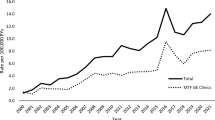Abstract
In recent years, there has been a marked increase in the diagnostic workups for celiac disease among military personnel, thereby significantly increasing overall laboratory testing expenditures and burden. We evaluated the serologic testing procedure in symptomatic young adults, using a “cost–effect” approach. We evaluated the serologic screening policy for celiac disease among serologically tested military personnel. The study population was divided into subgroups according to the clinical presentation prior to screening: isolated (low-risk) and combined complaints (high-risk). Sensitivity, specificity, and predictive values of serologic markers for celiac disease were evaluated. Cost analyses were based on diagnostic expenditures. Cost–effect ratio is expressed as cost per newly diagnosed patients, and cost minimization as cost per screened individuals. Five hundred thirty-eight military personnel were serologically tested for celiac disease. Eight new cases of celiac were diagnosed, all of whom belonged to the high-risk subgroup and tested positive for at least two positive serologic tests (tTG + EMA or tTG + AGA IgG + EMA). EMA Ab measured the highest sensitivity, specificity, and predictive values. Average screening expenditure was U.S. $287 per patient. The lowest cost–effect and cost minimization ratios were achieved by implementing a two-step single-marker screening protocol for high-risk subjects and one-step follow-up for low-risk subjects. Among patient population of young adults, selective diagnostic workup could result in cost-minimization without risking quality of diagnosis. From a cost–effect perspective, implemented screening procedures need to be dependent on subgroup: low-risk, clinical follow-up; and high-risk, serological testing for EMA and, only if positive, possibly a small-bowel biopsy.
Similar content being viewed by others
References
Farrell RJ, Kelly CP: Celiac sprue. N Engl J Med 346(3):180–188, 2002
Fasano A, Catassi C: Current approaches to diagnosis and treatment of celiac disease: An evolving spectrum. Gastroenterology 120:636–651, 2001
McPherson RA: Commentary: advances in the laboratory diagnosis of celiac disease. J Clin Lab Anal 15:105–107, 2001 (abstr)
McManus R, Kelleher D: Celiac disease—the villain unmasked? N Engl J Med 348(25):2573–2574, 2003
Isselbacher KJ: Celiac disease: Often underdiagnosed and clinically silent. http://www.harrisonsonline.com, 2001–2003 (McGraw–Hill)
Pruessner TH: Detecting celiac disease in your patients. http://www.aafp.org, 1998 (American Academy of Family Physicians)
Kelly CP: Use of serum antibodies to diagnose celiac disease. http://www.uptodate.com, 2003 (UpToDate)
Rostami K, Kerckhaert J, Tiemessen R, von Blomberg BM, Meijer JWR, Mulder CJJ: Sensitivity of antiendomysium and antigliadin antibodies in untreated celiac disease: Disappointing in clinical practice. Am J Gastroenterol 94:888–894, 1999
Johnston SD, Watson RGP, McMillan SA, et al.: Coeliac disease detected by screening is not silent—simply unrecognized. Q J Med 91:853–860, 1998
Shamir R, Lerner A, Shinar E, et al.: The use of a single serological marker underestimates the prevalence of celiac disease in Israel: A study of blood donors. Am J Gastroenterol 97:2589–2594, 2002
Gomez JC, Selvaggio G, Pizzaro B, et al.: Value of a screening algorithm for celiac disease using tissue transglutaminase antibodies as first level in a population-based study. Am J Gastroenterol 97:2785–2790, 2002
Corrao G, Corazza GR, Andeani ML, et al.: Serological screening of coeliac disease: choosing the optimal procedure according to various prevalence values. Gut 35:771–775, 1994
Harewood GC, Murray J: Diagnostic approach to a patient with suspected celiac disease—A cost analysis. Dig Dis Sci 46:2510–2514, 2001
Ferreira M, Davies S, Butler M, et al.: Endomysial antibody: Is it the best screening test for celiac disease? Gut 33:1633–1637, 1992
Weiss B, Bujanover Y, Avidan B, Fradkin A, Weintraub I, Shainberg B: Positive tissue transglutaminase antibodies with negative endomysial antibodies: Low rate of celiac disease. IMAJ 6:9–12, 2004
Clemente MG, Musu MP, Frau F, Lucia C, De Virgiliis S: Antitissue transglutaminase antibodies outside celiac disease. J Pediatr Gastroenterol Nutr 34(1):31–34, 2002
Author information
Authors and Affiliations
Corresponding author
Rights and permissions
About this article
Cite this article
Yagil, Y., Goldenberg, I., Arnon, R. et al. Serologic Testing for Celiac Disease in Young Adults—A Cost–Effect Analysis. Dig Dis Sci 50, 796–805 (2005). https://doi.org/10.1007/s10620-005-2576-y
Received:
Accepted:
Issue Date:
DOI: https://doi.org/10.1007/s10620-005-2576-y




